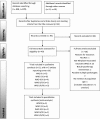Physiotherapy rehabilitation for whiplash associated disorder II: a systematic review and meta-analysis of randomised controlled trials
- PMID: 22102642
- PMCID: PMC3221298
- DOI: 10.1136/bmjopen-2011-000265
Physiotherapy rehabilitation for whiplash associated disorder II: a systematic review and meta-analysis of randomised controlled trials
Abstract
Objective To evaluate effectiveness of physiotherapy management in patients experiencing whiplash associated disorder II, on clinically relevant outcomes in the short and longer term. Design Systematic review and meta-analysis. Two reviewers independently searched information sources, assessed studies for inclusion, evaluated risk of bias and extracted data. A third reviewer mediated disagreement. Assessment of risk of bias was tabulated across included trials. Quantitative synthesis was conducted on comparable outcomes across trials with similar interventions. Meta-analyses compared effect sizes, with random effects as primary analyses. Data sources Predefined terms were employed to search electronic databases. Additional studies were identified from key journals, reference lists, authors and experts. Eligibility criteria for selecting studies Randomised controlled trials (RCTs) published in English before 31 December 2010 evaluating physiotherapy management of patients (>16 years), experiencing whiplash associated disorder II. Any physiotherapy intervention was included, when compared with other types of management, placebo/sham, or no intervention. Measurements reported on ≥1 outcome from the domains within the international classification of function, disability and health, were included. Results 21 RCTs (2126 participants, 9 countries) were included. Interventions were categorised as active physiotherapy or a specific physiotherapy intervention. 20/21 trials were evaluated as high risk of bias and one as unclear. 1395 participants were incorporated in the meta-analyses on 12 trials. In evaluating short term outcome in the acute/sub-acute stage, there was some evidence that active physiotherapy intervention reduces pain and improves range of movement, and that a specific physiotherapy intervention may reduce pain. However, moderate/considerable heterogeneity suggested that treatments may differ in nature or effect in different trial patients. Differences between participants, interventions and trial designs limited potential meta-analyses. Conclusions Inconclusive evidence exists for the effectiveness of physiotherapy management for whiplash associated disorder II. There is potential benefit for improving range of movement and pain short term through active physiotherapy, and for improving pain through a specific physiotherapy intervention.
Conflict of interest statement
Figures






Similar articles
-
Physiotherapy rehabilitation following lumbar spinal fusion: a systematic review and meta-analysis of randomised controlled trials.BMJ Open. 2012 Jul 24;2(4):e000829. doi: 10.1136/bmjopen-2012-000829. Print 2012. BMJ Open. 2012. PMID: 22833649 Free PMC article.
-
The Effectiveness of Integrated Care Pathways for Adults and Children in Health Care Settings: A Systematic Review.JBI Libr Syst Rev. 2009;7(3):80-129. doi: 10.11124/01938924-200907030-00001. JBI Libr Syst Rev. 2009. PMID: 27820426
-
Is immediate imaging important in managing low back pain?J Athl Train. 2011 Jan-Feb;46(1):99-102. doi: 10.4085/1062-6050-46.1.99. J Athl Train. 2011. PMID: 21214357 Free PMC article.
-
Telephone interventions for symptom management in adults with cancer.Cochrane Database Syst Rev. 2020 Jun 2;6(6):CD007568. doi: 10.1002/14651858.CD007568.pub2. Cochrane Database Syst Rev. 2020. PMID: 32483832 Free PMC article.
-
Complementary and alternative therapies for back pain II.Evid Rep Technol Assess (Full Rep). 2010 Oct;(194):1-764. Evid Rep Technol Assess (Full Rep). 2010. PMID: 23126534 Free PMC article. Review.
Cited by
-
Cervical facet joint platelet-rich plasma in people with chronic whiplash-associated disorders: A prospective case series of short-term outcomes.Interv Pain Med. 2022 Mar 9;1(2):100078. doi: 10.1016/j.inpm.2022.100078. eCollection 2022 Jun. Interv Pain Med. 2022. PMID: 39239374 Free PMC article.
-
Neck-specific exercise improves impaired interactions between ventral neck muscles in chronic whiplash: A randomized controlled ultrasound study.Sci Rep. 2018 Jun 25;8(1):9649. doi: 10.1038/s41598-018-27685-7. Sci Rep. 2018. PMID: 29941911 Free PMC article. Clinical Trial.
-
Thoracic dysfunction in whiplash-associated disorders: a systematic review and meta-analysis protocol.Syst Rev. 2016 Feb 9;5:26. doi: 10.1186/s13643-016-0201-0. Syst Rev. 2016. PMID: 26860082 Free PMC article.
-
Clinical Characteristics and Patient-Reported Outcomes of Primary Care Physiotherapy in Patients with Whiplash-Associated Disorders: A Longitudinal Observational Study.Patient Prefer Adherence. 2020 Sep 28;14:1733-1750. doi: 10.2147/PPA.S262578. eCollection 2020. Patient Prefer Adherence. 2020. PMID: 33061316 Free PMC article.
-
Properties of patient-reported outcome measures in individuals following acute whiplash injury.Health Qual Life Outcomes. 2014 Mar 13;12:38. doi: 10.1186/1477-7525-12-38. Health Qual Life Outcomes. 2014. PMID: 24625124 Free PMC article.
References
-
- Spitzer WO, Skovron ML, Salmi LR, et al. Scientific monograph of the Quebec Task Force on Whiplash Associated Disorders: redefining ‘whiplash’ and its management. Spine (Phila Pa 1976) 1995;20(8 Suppl):1S–73S - PubMed
-
- Holm LW, Carroll LJ, Cassidy JD, et al. The burden and determinants of neck pain in Whiplash associated disorders after traffic collisions, results of the Bone and Joint Decade 2000-2010 Task Force on Neck pain and its Associated Disorders. Spine (Phila Pa 1976) 2008;33(4 Suppl):S52–9 - PubMed
-
- Burton K. Treatment guidelines: is there a need? Proceedings of Whiplash Conference 2003, Bath, England, 6–8th May. Bristol: Lyons Davidson Solicitors, 2003
-
- Barnsley L, Lord S, Bogduk N. Whiplash injury: clinical review. Pain 1994;58:283–307 - PubMed
LinkOut - more resources
Full Text Sources
